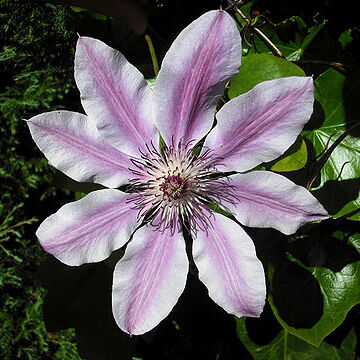Dioecious or polygamo-monoecious, lignescent vines, climbing by means of foliar tendrils (in Central America). Leaves opposite, exstipulate, ternately, pin-nately or biternately compound, the leaflets entire to coarsely dentate, often asymmetrical, 1-to 5-plinerved, glabrous to densely sericeous, the rhachis usually pubescent, often twining. Inflorescences of cymes or umbels racemosely disposed along the bracteate, often elongate main axis, unisexual or polygamous; sepals 4-5, valvate, white, greenish or purplish, often petaloid; stamens numerous, sepa-rate, the filaments flattened and elongate, the anthers basifixed, 2-celled, longi-tudinally dehiscent; carpels numerous, separate, the styles comose. Fruit a dry arcuate-ellipsoid achene terminated by the elongate indurate, hirsute style, the ovule pendulous on the dorsal raphe.
Vines woody or herbaceous and perennial, rarely erect shrubs, subshrubs, or perennial herbs. Leaves opposite, rarely fascicled or alternate, simple or compound; leaf or leaflet blades palmately veined. Inflorescences cymose, sometimes solitary, usually pedunculate, 2-bracteate. Flowers bisexual or unisexual. Sepals 4 or 5(--8), petaloid, spreading, ascending, or erect, usually valvate in bud. Petals absent. Stamens numerous, sometimes outer ones sterile and becoming linear or petaloid staminodes; anthers introrse. Carpels numerous, usually pubescent or villous; ovaries 1-ovuled; ovule pendulous. Style elongated after anthesis, rarely slightly or not elongated. Achenes usually ± bilaterally compressed; persistent style usually strongly elongated, plumose.
Woody climbers, perennial herbs (not in Australia), or rarely shrubs. Leaves opposite, usually compound, once or twice ternate, 1–4 times pinnate, rarely simple, in some species ending in tendrils; petioles and petiolules often twining and acting as tendrils. Flowers in dichasial panicles or solitary, actinomorphic, bisexual or plants dioecious. Tepals usually valvate, mostly 4 (rarely to 8), petaloid. Stamens many; anthers often with a terminal connective-appendage. Male flowers sometimes with ± petaloid staminodes. Female flowers usually with 1 whorl of staminodes. Carpels numerous. Ovule solitary. Fruit a globular head of 1-seeded achenes, each with a persistent, long, often plumose style (awn).
Perennial woody climbers or rarely terrestrial herbs. Lvs cauline, opposite, simple to ternate to 1-2-pinnate; leaflets entire or lobed. Fls ☿ or unisexual, solitary or in axillary fascicles or simple to compound dichasial cymes; involucre 0 but bracts sometimes connate in pairs. Perianth of 1 petaloid whorl of sepals; sepals 4-6-(8), white, yellow, pink, blue or violet, without nectaries or spurs. Stamens many, spiralled; staminodes present or 0, sometimes petaloid or nectariferous. Carpels with 1 functional ovule. Achenes many, lanceolate to ovate; style elongated and feathery. Receptacle glabrous or hairy.
Mostly woody climbing or suffruticose trailing plants. Leaves opposite, generally compound, petiole and rhachis capable of twining round supports but not ending in a naked tendril. Flowers regular, in many-to few-flowered panicles or solitary. Sepals 4 (rarely more), valvate, more or less petaloid. Petals and nectaries absent but staminodes, which gradually pass into the stamens, sometimes present. Carpels indefinite in number, normally uniovulate by abortion. Achenes capitate, with a persistent usually elongated plumose or naked style.
Sep petaloid, valvate in bud, commonly 4, sometimes more; pet none; staminodes present or absent; pistils numerous; fr a flattened achene, terminated by the elongate, persistent style; erect perennial herbs, or herbaceous or somewhat woody vines climbing by the prehensile lf-rachis, with opposite, simple or compound lvs and solitary or panicled, medium-sized to large fls, usually dioecious; x=8. (Atragene, Viorna) 300, cosmop. Species of the section Viorna are called Leather-flower or Curly heads.
Sepals 4-8, petaloid, valvate; petals 0; stamens ∞, anthers adnate. Carpels ∞; ovule solitary, suspended. Fruit a cluster of sessile achenes with elongate persistent styles. Soft-wooded lianes or sub-shrubs with opp. us. compound lvs. Some 250 spp., mainly of temperate regions. The N.Z. spp. are endemic and dioec. or polygamo-dioec.
Petals and nectaries absent but staminodes transitional between sepals and stamens sometimes present.
Leaves opposite, usually pinnately or ternately compound with petiole and rhachis capable of twining.
Achenes capitate with a persistent, usually elongated, plumose or naked style.
Flowers actinomorphic in many-to few-flowered panicles or solitary.
Carpels indefinite in number, free, normally 1-ovulate by abortion.
Mostly woody climbers or shrubby trailing plants.

